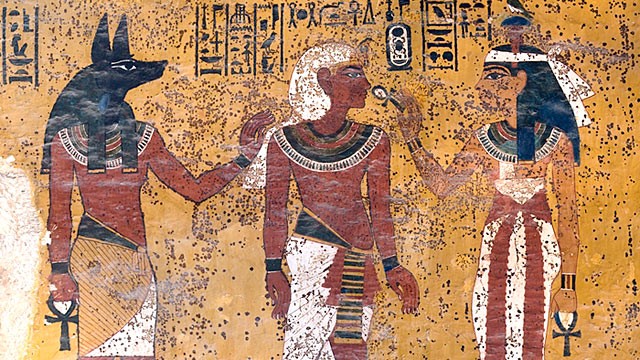ok, so not really a post about how bacteria, fungi or other microbes can assist in higher-yield plant growing, but an interesting microbe-related news story, nonetheless.
abc news relates a scientific study into the brown splodges which Howard Carter noted, upon opening Tutankhamun's tomb, back in the 1920's.

"There are some marvellous objects here," Carter reported. The king's sarcophagus. His elaborate death mask and throne, all covered in gold. Jewelry, statues, great urns. And the spectacular hieroglyphs on the walls.
But why were there brown blotches all over everything? They are everywhere -- on paint, on plaster, on silver. Just look at the pictures. Tut's tomb was infested with something that Egypt's Supreme Council of Antiquities could not identify.

Close-up tomb painting of Tutankhamen.
Concerned that the endless stream of tourists over the years had potentially exacerbated the problem (what with the moisture from all that sweat, the tourists breathing over the walls, etc) the Egyptian Auuthorities contacted called the Getty Conservation Institute in Los Angeles, which called Ralph Mitchell, a microbiologist at the Harvard School of Engineering and Applied Sciences. After a year's research, they are now able to lay the original concern to rest.

Howard Carter, said Mitchell, was a good scientist. When he entered the tomb 90 years ago, he catalogued and photographed everything. He has been accused over the years of mishandling Tutankhamen's mummy, but he was nothing if not thorough. He noted the brown spots and photographed them back in 1922.
"They have not grown since then," said Mitchell.
But that, as they say in many a mystery story, is where the plot thickens. After DNA sequence analysis, modern researchers still cannot say what the ancient microbes were, other than that they may have been some sort of fungi. And beyond that, why was Tut's tomb -- just this one among the many from ancient Egypt that are less well preserved -- so blighted?
"The guessing, and it's only a guess," said Mitchell, "is that he died suddenly, and was buried quickly, before the plaster even had a chance to dry. The people finishing the tomb would have exhaled, lost flecks of dry skin -- there would have been enough organic matter in the tomb that microbes grew on the walls."

No comments:
Post a Comment